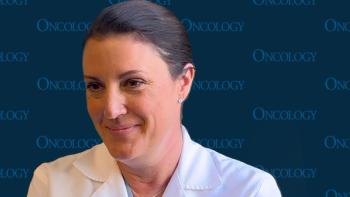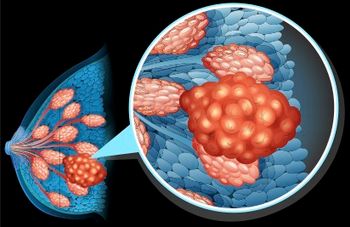
- ONCOLOGY Vol 10 No 10
- Volume 10
- Issue 10
New Cancer Gene Marker Could Help Tailor Chemotherapy for Breast Cancer
Researchers at Duke University Comprehensive Cancer Center have found that a newly identified liver cancer gene is also defective in more aggressive breast tumors that may not respond to certain common types of chemotherapy.
Researchers at Duke University Comprehensive Cancer Center havefound that a newly identified liver cancer gene is also defectivein more aggressive breast tumors that may not respond to certaincommon types of chemotherapy.
The researchers say that determining whether breast cancer patientshave mutations in this gene could help tailor the most effectivetreatment for individual patients. Their research is reportedin the May issue of Oncogene.
The malfunctioning gene, recently shown by the Duke researchersto be important in transforming normal liver cells into cancercells, now has also been demonstrated to be defective in about30% of cases of sporadic breast cancer. The gene, mannose 6-phosphate/insulin-likegrowth factor H receptor (M6P/IGF2r), codes for a protein thatnormally helps control cell growth--a so-called tumor suppressor.
"This study provides a first step in what we believe willbe the future of breast cancer treatment: customizing therapyto each individual case," said Randy Jirtle, professor ofradiation oncology at Duke. "People tend to think of breastcancer as a single disease, but in reality there are many independentevents in the cell that can lead to uncontrolled growth. We arebeginning to learn now that one size doesn't fit all in cancertreatment."
Jirtle's coauthors on the Oncogene paper are Gerald R. Hanking,Rex Bentley, Mihir Patel, Jeffery Marks, and James D. Iglehartof Duke and Angus De Souza of Zeneca Pharmaceuticals, Cheshire,England. The research was supported by grants from the NationalCancer Institute, The Proctor and Gamble Company, Zeneca Pharmaceuticals,and MITRE Corporation.
Gene Testing May Aid in Drug Selection
As researchers have learned more about what causes a cell to becomecancerous, they have begun to realize that treatments that workfor some tumors involving gene mutations are useless for others.
"Just as doctors routinely use diagnostic tests to choosethe most effective antibiotic to fight a specific type of bacterialinfection, we are beginning to determine which chemotherapy drugsare effective against specific types of tumors," Jirtle said."Our results suggest testing for this new gene may help doctorsdecide which treatment will work best in individual cases."
To help sort out the roles of different genes in tumor growth,the Duke researchers focused on the M6P/IGF2r gene. Previous studieshad shown that M6P/IGF2r is often mutated in early-stage livertumors, demonstrating that it plays an important role in the initialprogression of liver cancer.
To determine whether the M6P/IGF2r gene also plays a role in breastcancer, the researchers studied tissue from breast tumors of 62patients. Normally, people have two copies of the gene. Even ifone copy of the gene has a mutation, the other good copy can compensate.But when the good copy becomes deleted through a second mutation,the protein's tumor-fighting ability is lost completely. The Dukeresearchers showed that in 30% of breast cancers studied, thistumor-fighting gene was lost.
The M6P/IGF2 protein is present in all cells of the body, whereit performs several important functions that control cell growth,Jirtle said. It deactivates a potent growth promoter and helpsactivate a potent growth inhibitor, transforming growth factor-beta-l(TGF-beta-l). High levels of TGF-beta-l help stop the growth ofmany tumor types.
Presence of Gene May Predict Responsiveness to Tamoxifen
The commonly used cytostatic drug tamoxifen (Nolvadex) appearsto work, in part, by prompting cells to produce larger quantitiesof TGF-beta-l, which is released in an inactive form. To becomeactivated, TGF-beta-l requires the M6P/IGF2 receptor. If the M6P/IGF2receptor is missing or inactive because of mutation, TGF-beta-lcan't do its job.
"Many times it is difficult to discern which patients willrespond to tamoxifen treatment," Jirtle said. "Thisresearch suggests that if the M6P/IGF2 receptor is inactivated,cytostatic drugs such as tamoxifen may not be as effective."
Similar studies conducted by Jirtle and colleagues at the Universityof Wisconsin, Madison, have shown that two promising anticancerdrugs, limonene and perillyl alcohol, work by increasing levelsof both TGF-beta-l and the M6P/IGF2 receptor. Limonene is a componentof citrus fruit peel, and perillyl alcohol is a lavender extract.They belong to the same broad class of antitumor agents as tamoxifen.
Previous studies by Jirtle's group at Duke and Michael Gould atWisconsin have shown that, in rats, limonene caused 87% of advancedmammary tumors to shrink. However, in cells in which the levelsof M6P/IGF2 receptor did not increase, suggesting that the geneis defective, limonene was also ineffective.
Gould and colleagues are now conducting phase I safety studiesof perillyl alcohol in breast cancer patients and later this yearplan to proceed to phase II studies that will assess its effectivenessin treating breast cancer tumors.
The Duke team will test tumor tissue from each patient to determinewhether mutations in the M6P/IGF2 receptor indeed correlate withresponsiveness to the drug. The study could help doctors identifywhich patients would be the best candidates for treatment withthe new drugs, should they be approved for general use, Jirtlesaid.
Articles in this issue
about 29 years ago
Cigarette Smoking Among Adults--United States, 1994about 29 years ago
New Clues To Cancer Growth Discoveredabout 29 years ago
Survey Results: Kicking the Habit Tough for US Tobacco Farmersabout 29 years ago
Nursing Challenges of Caring for Patients with HIV-Related Malignanciesabout 29 years ago
Possible New Approach to Preventing Chemotherapy Drug Resistanceabout 29 years ago
Genetic Tests Further Complicate Ovarian Cancer ControversiesNewsletter
Stay up to date on recent advances in the multidisciplinary approach to cancer.


















































































